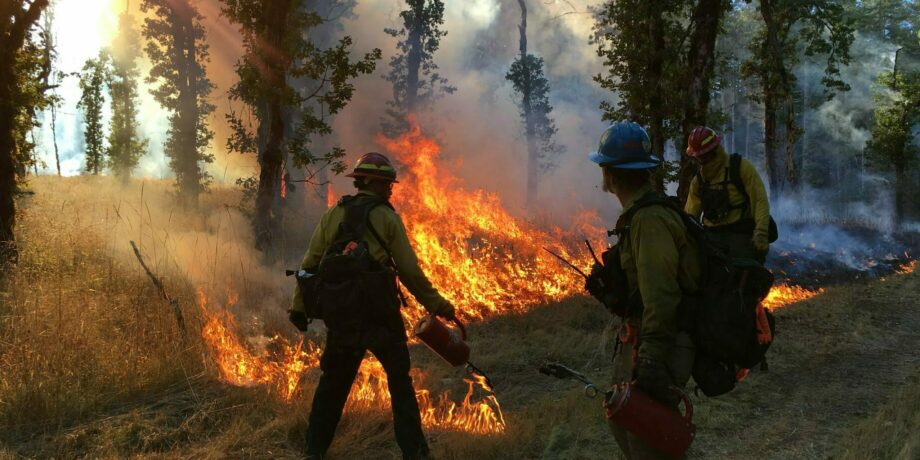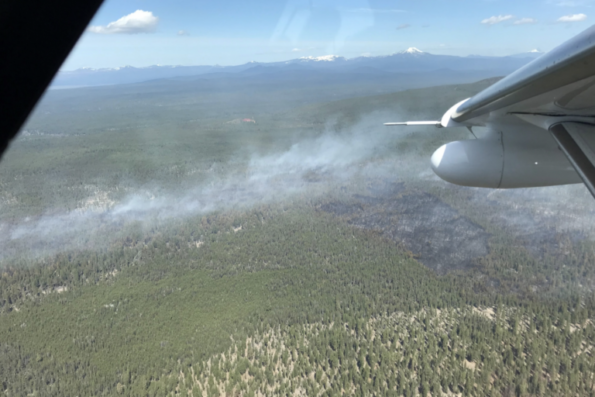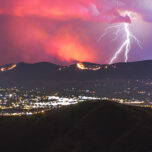December 4, 2023 — Editor’s note: This story first appeared in Mongabay and is republished here with permission.
Click here for highlights from the story.
-
-
- Prescribed fires are a positive land management method, but when the flames occasionally escape control, the resulting damage to land and private property also hurts this conservation tool’s reputation.
- U.S. insurance companies are thus charging increasingly unaffordable premiums for coverage of this activity or are dropping the service altogether in the wake of some particularly large recent accidents.
- As a result, many small conservation groups and private businesses are getting out of the habit of using fire to improve grassland health, boost wildlife habitat, and decrease likelihood of catastrophic wildfires.
- California is bridging this gap with a new state program that insures the activity, while prescribed fire associations, where residents and firefighters cooperate to carry out burns on private land, are increasingly popping up in communities.
-
On the first day of a 2021 prescribed fire in south-central Oregon, all went to plan as firefighters slowly burned areas in Fremont-Winema National Forest. They created a deliberate mosaic alternating between swatches of blackened land and decadent foliage.
Fire specialists designed the operation to reduce risk to the nearby Sprague River Valley community and improve the quality of forage for mule deer through bitterbrush regeneration. But the next morning, winds blew embers over trenches meant to contain the flames. Small fires ignited in patches of grass and went up small trees until they grew into the very thing the firefighters were trying to prevent: a wildfire.
Declaring the prescribed burn a wildfire, called the Meadow Fire, was costly, but it brought in resources such as a large plane to control its spread and divert flames away from homes. That hasn’t been the case for other prescribed burns like last year in New Mexico, where windy conditions fueled out-of-control fires that forced evacuations and destroyed hundreds of homes.
These escaped burns exacerbate concerns among people who live in fire-prone communities and who are skeptical of using fire as a method to reduce unwanted wildfires. The same goes for insurance providers whose liability coverage is limited and increasingly unaffordable, with an annual premium as high as US$100,000 for US$1 million of coverage. This financial barrier is one of the primary obstacles to getting more burns done in the American West.
“An escape on a prescribed burn, it’s very rare. You hear about them when they happen, but the percent is probably less than 1% of the time,” says Sean Hendrix, who has been a burn boss on prescribed fires in Oregon for 20 years — the last escape there was the Meadow Fire — and has never had an out-of-control burn on his watch.
His experience lines up with statistics from the U.S. Forest Service: Of the average 4,500 fires the agency conducts each year, about six escape. That’s 99.84% of prescribed burns happening without any issues.
The low number of incidents is a result of science-based planning for fire behavior, which is crucial because prescribed fire has proved to be an effective tool for natural resource management, from dry-ecosystem restoration to the conservation of creatures ranging from endangered sandhill cranes to rare crayfish species.
The U.S. Fish and Wildlife Service and partners performed important work to reduce the risk of catastrophic wildfires while helping to improve key wildlife habitat at William L. Finley National Wildlife Refuge. Video by Brent Lawrence | USFWS, CC BY-NC 4.0 Deed
Carrying out this work is already expensive, so the bloated cost of insurance is hitting the bottom line hardest for nonprofit conservation groups and private companies like the one Hendrix works for, Grayback Forestry. The premiums represent such a cost to these small organizations that some are getting out of burn projects entirely.
While premiums vary and aren’t generally advertised, Hendrix says rates for private forestry companies working with fire are 10 times what they were four years ago. That cost comes back to the groups hiring them to do the work, such as government agencies, conservation organizations, Native tribes and small landowners.
“It’s just really raised the price of burning,” Hendrix says, adding these are now going for US$1,200 an acre (nearly US$3,000 per hectare). “The cost of the liability insurance has skyrocketed, so we have to charge more, and that’s the hurdle.”
Changing perspectives on fire
The American West’s new embrace of prescribed fire follows a reckoning with a violent history that left its ecosystems in a dangerous disarray.
The U.S. government removed fire from the landscape along with Indigenous communities who had lived there since time immemorial and had used fire as a cultural management tool: As tribes were displaced in the early 1900s, new laws required wildfire suppression, which bred crowded forests and overgrown vegetation. This legacy, paired with carbon pollution’s warming and drying of the atmosphere, means it only takes a small spark to set these dried-out forests and grasslands ablaze for weeks.
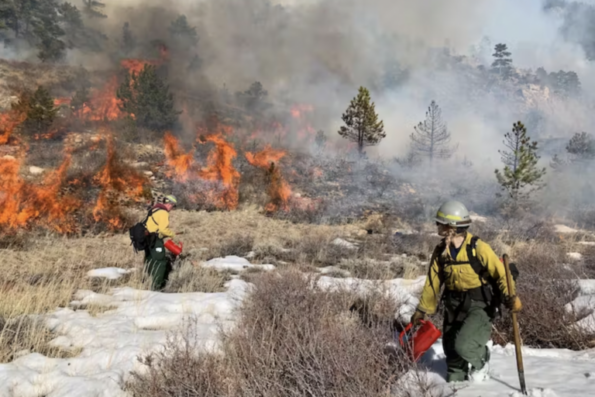
A prescribed burn crew works in the Arapahoe and Roosevelt national forests, Colorado, February 2019. Image courtesy of the U.S. Forest Service.
“A lot of California was adapted to frequent fire, and we’ve taken that away for 100, 150 years now, and the impacts have been immense,” says Lenya Quinn-Davidson, the fire network director for the University of California’s Division of Agriculture and Natural Resources.
“Here, [fire] was pretty much completely squashed for two generations, and so we lost that cultural continuity, and I think that is one of the struggles in the West right now, is to build back that culture of fire,” she says.
Quinn-Davidson says she believes that to bring that culture back, fire management must be viewed as a public service that benefits people and their environments, and governments must help fund it.
When government agencies, nationally or locally, conduct a burn, they’re essentially self-insured. Government-led burns also cover the individual carrying out the treatment, if the fire escapes and they were within the scope of work.
That’s not the case for private companies, nonprofits and landowners. Generally, insurance coverage for prescribed fire is provided within an umbrella of commercial liability policies for logging, farming or other small businesses. Many of those providers have dropped clients who work with fire, according to Quinn-Davidson. And for those who do have the insurance, they must pay for it year-round. Quinn-Davidson once worked with a nongovernmental organization that found an insurance provider willing to offer per-day insurance for prescribed fires, but it was a budget buster at around US$5,000 a day.
As a solution, she worked with a team of legislators, tribal leaders and fire practitioners to develop the Prescribed Fire Liability Claims Fund. Launched in June, the pilot program covers fire practitioners, both prescribed and cultural — the latter an application by tribes for ecological purposes or ceremonial activities.
The California Department of Forestry and Fire Protection (CalFire) administers up to US$2 million in coverage for those who apply ahead of a burn, while neighboring states such as Oregon are trying to roll out similar programs while engaging with providers on the need for affordable insurance. The Oregon legislature required a prescribed fire liability study in 2021 to better understand hesitancy among insurers.
“Prescribed fire is really still viewed as a conservation benefit. It doesn’t have an economic value. There’s not a robust market for it. There’s really no incentive for anyone to provide that coverage,” says Dylan Krause, vice president at Sustainable Northwest, an advocacy group that brings entrepreneurial solutions to natural resource challenges.
“We’ve seen a dynamic with insurance providers where there were very few to begin with, but increasingly as we have landscapes that are more fire prone, we’ve got climate change, more drought, we’ve got hotter seasons,” Krause says. “Providers are saying, ‘I understand that it’s 99.9% safe, but what’s in it for me, and is it even worth it at this scale?’”
That’s a perspective that some are going to great lengths to change.
Growing roles for grassroots organizing and tech
A social movement of sorts now seeks to help companies, landowners and citizens understand the public value of prescribed fire, and to get it on the ground amid financial constraints, leading to a rise in prescribed fire associations in communities across the U.S. West. Residents and firefighters are banding together to carry out burns on private land, and they share resources, expertise and equipment, but education and training is at the core of what they do.
“We tend to think of fire as this malicious thing that we can’t work with because it’s inherently unpredictable,” says Chris Adlam, a regional fire specialist with Oregon State University’s Extension Service who’s involved with the Rogue Valley Prescribed Burn Association.
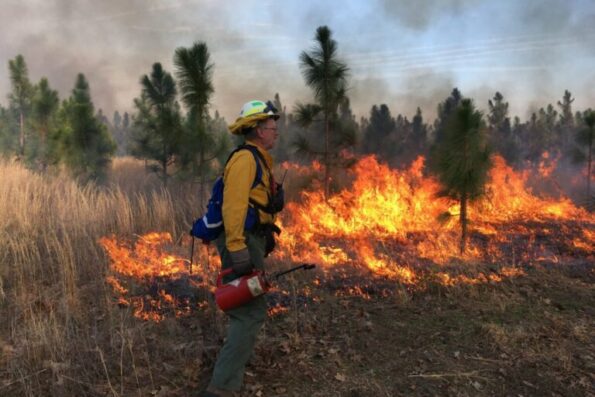
Prescribed burns conducted by government organizations don’t face the same high cost of fire insurance as private organizations do. Image courtesy of the Virginia Department of Forestry.
“But, in fact, fire does things in a very predictable way. And once you understand how fire behaves, you can change how you’re putting fire on the ground,” he says.
To prove this, Adlam and others are looking at how technology can help convey the methodology of prescribed burns. An example of this is drones that capture infrared imagery and patrol for flames outside of the prescribed fire boundary.
It’s a tool that Hendrix’s company has now incorporated into its burn plans, in an effort to keep rates down with its own insurance provider. Those burn plans typically require firefighters to patrol for four or five days afterward to monitor for smoke and embers.
“You really need to be checking your burn for like seven to 10 days after, and that’s where we come in with our drone,” Hendrix says. “At the end when [we] haven’t smelled the smoke, we fly the [drone] at night or early in the morning, and with our thermal imaging, it will give the temperature of whatever you’re seeing.”
The thermal imaging is then sent to insurance providers to prove the burn was conducted without any issue. But Hendrix says he knows this approach isn’t attainable for everyone: The technology costs upward of US$15,000 to acquire. He says he’s optimistic for the future, though, because he’s starting to see the culture around fire shift.
“We’ve got to use all the tools in the toolbox for prescribed burning. And there’s a cost to it. But [it’s] becoming more socially acceptable,” Hendrix says. “I think we’re at a point where it’s finally going to balance out, with the insurance companies coming around.”
Related Posts
Ensia shares solutions-focused stories free of charge through our online magazine and partner media. That means audiences around the world have ready access to stories that can — and do — help them shape a better future. If you value our work, please show your support today.
Yes, I'll support Ensia!